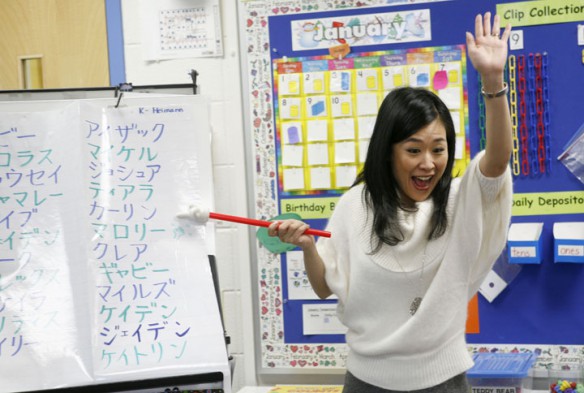
Miko Momozono teaches Japanese to Beth Heimann’s kindergarten class at Picadome Elementary School (Fayette County). Photo by Amy Wallot, Jan. 10, 2012
By Susan Riddell
susan.riddell@education.ky.gov
Miko Momozono teaches students at Picadome Elementary School (Fayette County) Japanese at the same time they are still learning the finer points of English.
While that may seem like a difficult task, the third-year language teacher said it’s just the opposite.
“It actually makes it easier because they are right in the spot of learning their mother tongue,” Momozono said. “Students are inhaling Japanese just as they are acquiring English day by day.
“I have students who are English language learners who speak a second language at home,” Momozono added. “These students often excel in learning Japanese since they have already had a head start in acquiring English as a second language. Japanese may be their third or fourth language. Amazingly, students do not confuse the multiple processes of language learning.”
All the research points to the best and easiest time for students to acquire another language being before age 10, said Jacque Van Houten, world language and international education consultant for the Kentucky Department of Education (KDE).
“Sure, you can learn after that, but it becomes more of an exercise in learning than acquiring language and involves a different cognitive approach,” she said.
Fayette County has 21 elementary schools offering at least one foreign language: Spanish (10), Spanish Immersion (3), Chinese (6) or Japanese (3). Northern Elementary School offers both Spanish and Spanish Immersion classes.
Districts of all sizes are following this trend, from those as small as Cloverport and Danville independents to larger districts like Woodford and Christian counties.
“Covington Independent submitted a grant proposal for a summer school Chinese language program that is arts-based and may offer high school credit to students who achieve a targeted proficiency level,” Van Houten said.
The move dovetails with the Kentucky Board of Education’s (KBE) decision to implement world language Program Reviews in elementary schools in the 2014-15 school year as part of the state’s Unbridled Learning assessment and accountability system. The reviews would not be included in school or district accountability until the 2015-16 school year.
Education Commissioner Terry Holliday directed Kentucky Department of Education (KDE) staff this past October to begin working with superintendents and schools to identify best practices in world language instruction and collaborate on ways to build instructional capacity in preparation for world language Program Reviews.
Alicia Vinson, world language immersion program coordinator for the Fayette County school district, said globalization is making it crucial for primary students to get an early start in learning another language.
“Kentucky students need opportunities to learn a broad range of languages to prepare them for future economic, diplomatic, educational and personal endeavors,” Vinson said. “Students should have access to an uninterrupted sequence of instruction in one language in order to reach a higher level of language proficiency.
World language education programs of today prepare tomorrow’s citizens, she added.
“Globalization has blurred our borders and expanded our horizons. In today’s global economy, learning other languages and culture is vital to our students’ future as members of the workforce and to Kentucky’s future success in the world,” Vinson said.
Language learning reinforces other subjects, too, she said.
“Strong elementary language programs can strengthen the achievement of younger students in other subjects and skill areas,” she said.
Van Houten said it’s critical that young students are exposed to other languages more than just a few times a week.
“Language should be taught naturally, focusing on content, rather than teaching lists of words,” she said. “Teachers should use phrases and sentences, with plenty of visuals, gestures, movements and sounds to make it comprehensible to learners.
“It’s unrealistic to expect children to learn to use a language with any degree of proficiency if it’s only offered once or twice a week for 20 or 30 minutes,” Van Houten added. “Research shows us that children acquire language when they have routine exposure to language in natural speech. They require lots of input first and opportunities to produce language when they are ready. Content-based, hands-on learning opportunities such creating artwork, performing a dance, doing mathematics computations, aerobic exercises or sports all help students acquire language.”
Momozono said Picadome Elementary School K-2 students received 20 minutes of Japanese instruction a day while students in grades 3-4 get 90 minutes over the course of a week.
“In 3rd and 4th grade, reading and writing are emphasized more,” Momozono said. “The students are introduced to the character writing. (There are three writing systems in Japanese.) You may think it is complicated, but actually students seem to enjoy learning characters in spite of the differences from learning English spelling. Fourth graders are excited to have an individual pen pal in Japan from our partner school, Yahata Kita Elementary School. Students are intrinsically motivated to write to their friends.”
Momozono said in her class students acquire Japanese language through visuals and kinesthetic materials that create the context.
“Such context-building is important because we want to keep the class instruction in the target language 95 percent or higher,” she said. “Although this Japanese program is not an immersion program, the students are immersed with Japanese language during the lesson.”
Momozono said Picadome students can continue learning Japanese one they attend Jessie Clark Middle School and Lafayette High School. Next year, Lafayette students can take Advanced Placement Japanese.
“Japanese language speakers are well-desired with good salaries in the U.S., especially here in Kentucky where there are many employment opportunities in Japanese companies,” Momozono said. “Knowing the language and culture will (be an advantage). Not only do the private sectors seek people who are able to use Japanese, but in the fields of medicine, agriculture, military and national security, people are needed who can manipulate the language well.”
Knowing a language, she said, also will help her students develop an open mind, curiosity and wide perspective on the world and their future, which is essential in making decisions for their secondary education or career plans, she said.
“I dream my students will achieve career success whatever their arena will be in the world. The opportunities to utilize their language ability are abundant since the world has become so small. You can now communicate freely and globally with a click,” Momozono said.
MORE INFO …
Jacque Van Houten, jacqueline.vanhouten@education.ky.gov, (502) 564-2106
Walter Hulett, walter.hulett@knox.kyschools.us, (606) 546-3157
Miko Momozono, mitsuko.momozono@fayette.kyschools.us, (859) 381-3563
Alicia Vinson, alicia.vinson@fayette.ky.schools.us, (859) 381-4000














Leave A Comment